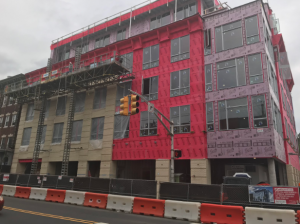If there’s a center for multifamily real estate developers right now, it’s northern New Jersey.
According to City-Data.com, 10 of the top 21 cities with the highest percentage of renters are in a narrow band of five counties along the west bank of the Hudson River. The range goes from two-thirds of Hoboken citizens to 80% of those who call neighboring Union City home.
Government agencies have a broad definition of “northern New Jersey” which encompasses 13 counties that reach almost all the way south to Atlantic City, including the Philadelphia suburbs from the southwest corner of the expansive region. For our purposes, though, it’s best to focus on that tangle of light rails and all-night bus routes that stretch from New Brunswick in the southeast to Passaic in the north because that’s where the action is: in commuting distance from Manhattan.
Across all classes
The headlines are always about the Class A units coming online. They make for the prettiest pictures, certainly. “Current developments are providing many of the same conveniences that can be found in Manhattan at a monthly savings of $1,000 or more on rent,” according to a recent Marcus & Millichap report. “The impact of this trend is most apparent among luxury products,” driving the vacancy rate for Class A rentals down to 7.5%.
With that said, the same report clarifies that there’s also plenty of action downmarket. “Investors have shown increased interest in Newark over the past four years,” the report continues. This is somewhat surprising because Newark has been the poster child for urban blight in northern New Jersey for generations. According to City-Data.com, you can buy an attached home for under $180,000, and the 2016 median gross rent was barely $1,000/mo. Unemployment is almost four times the national average. From 2009 to 2013, there were a total of nine building permits issued for a city of 280,000 residents. That makes 2014’s 32 permits — the latest figure available — seem positively frothy. One would have to go to Detroit to find a lower ratio of building permits per capita.
So why the sudden investor interest in Newark real estate? Doesn’t the paucity of building permits suggest otherwise? “I don’t think [building permits and investor interest] should correlate, especially in a town like Newark,” Marcus & Millichap’s New Jersey manager Brian Hosey tells Sharestates. The Class B and C investment is in “rehabbing existing stock and converting it. This doesn’t involve new development.”
Swimming upstream
Newark might be the biggest city in northern New Jersey, but it’s hardly the whole story in this economically diverse region. The Garden State’s quiet money is concentrated in Hunterdon County which, although it could technically be considered northern New Jersey, lies out Interstate 80 along the Pennsylvania border. It boasts annual family income in excess of $120,000 on average, and neighboring Morris and Somerset counties aren’t far behind.
But in that concentrated area roughly east of the Garden State Parkway, it’s Bergen County — with such leafy hamlets of Saddle River and Alpine — that has the sole distinction of a six-digit average annual family income. That said, there are any number of prosperous communities nested in less heralded counties. Blue-collar Essex County benefits from having Summit in its tax base. Hudson County boasts transit hub and gentrification success story Hoboken, where you can’t walk a block down Washington Avenue without some reminder you’re in Frank Sinatra’s hometown.
The most improved climate for real estate, according to Hosey, is Newark’s neighbor to the west. “In Irvington, crime is down something like 86 percent,” he says. City-data.com drills down into the numbers a little more, apparently backing his assertion. The declines in murders and robberies are particularly impressive.
And just as you can’t judge a state by a county or a county by a city, northern New Jersey’s cityscapes merit a closer look. Jersey City — which accounts for roughly one-third of northern New Jersey’s new construction units — is comprised of districts that each have their own flavor. There is, for instance, a world of difference between nouveau rich Historic Downtown and the more commercial Downtown. At the north end of the city — northern New Jersey’s second largest edged out by Newark — is The Heights. And although it is considered perhaps the lowest-income part of town, it really needs to be assessed block by block. West of Summit Avenue has socio-economic issues that the other parts of The Heights might not face. The part of The Heights up the palisade from Hoboken — the area real estate agents and neighborhood associations have taken to calling Riverview — is a place with a lot of new, well-heeled residents.

But perhaps the greatest turnaround is just below Essex County, home to the urban renewal of the Port of Elizabeth. “Transaction activity picked up the most year-over-year in the eastern portion of Union County,” the Marcus & Millichap report says. “There, several 20th century-built Class C properties south of Newark Airport changed hands at initial yields around 6 percent.”
Ultimately, northern New Jersey is hard to capture in a small snapshot such as a blog post. “It kind of reminds me of Brooklyn 20 years ago,” Hosey says. “There are lots of pockets of nice houses but, if you go five blocks in the wrong direction, it gets a little sketchy.”
Northern New Jersey at a glance
- New construction (projected): 9,700 units, more than half in Hudson County
- Vacancy rate (projected): 4.6%, a 0.3% increase from 2017 due to record-setting new construction
- Average effective rent: $1,855/mo, a 1.8% increase from 2017
- Median household income: $77,527, compared with U.S. median $61,179
- Proportion of households renting: 50%


